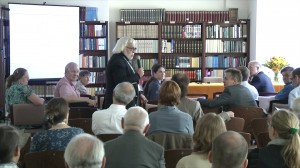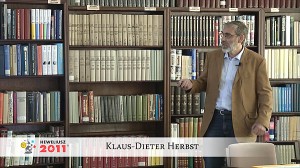Konferencja Hevelius 2011 – Sesja 7 – Suzanne Débarbat, Susan Keyes
 Temat: Archiwalia Heweliusza w Obserwatorium Paryskim i wpływ gdańskiego astronoma na Giovanniego Domenica Cassiniego.
Temat: Archiwalia Heweliusza w Obserwatorium Paryskim i wpływ gdańskiego astronoma na Giovanniego Domenica Cassiniego.
W Obserwatorium Paryskim znajduje się 16 tomów korespondencji Heweliusza, zawierających około 2500 dokumentów, oraz cztery tomy rezultatów jego obserwacji, w tym tablice astronomiczne, ryciny, miedzioryty, szkice listów i innych tekstów oraz kilka druków.
Uniwersytet Versailles-Saint Quentin oraz Obserwatorium Paryskie biorą udział w międzynarodowym projekcie, mającym na celu przygotowanie wersji cyfrowej i wydanie korespondencji oraz materiału obserwacyjnego. Projekt wymaga rozległych przygotowań, które same w sobie są przedsięwzięciem o charakterze naukowym. Wyniki analizy rękopisów i informacje o nich będą zapisywane w postaci metadanych. Obecnie trwa identyfikacja korespondentów Heweliusza, miejsc i dat itp. W pierwszej części wystąpienia przedstawione zostaną wstępne rezultaty tych prac.
Druga część wystąpienia zostanie poświęcona omówieniu wpływu Heweliusza na jednego z jego następców – Giovanniego Domenica Cassiniego (1625-1712). Cassini, szukając sposobu powiązania badań powierzchni Księżyca z metodą wyznaczania długości geograficznej, przedstawił dokładny opis zjawiska libracji optycznej Księżyca. Jego syn Jacques podał w 1740 roku w traktacie Eléments d’astronomie sformułowanie trzech praw ruchu Księżyca, które dla uczczenia zasług jego ojca są nazywane prawami Cassiniego. Badania Księżyca, rozpoczęte przez Heweliusza, są dziś równie ważne jak były w XVII wieku.
materiał w języku angielskim
Suzanne Débarbat (Paris Observatory), Susan Keyes (Paris Observatory; Université de Versailles Saint-Quentin):
Hevelius’s Archives at the Paris Observatory and His Impact on Giovanni Domenico Cassini
Sixteen volumes of Hevelius’s correspondence, approximately 2500 documents, and four volumes of his observations are preserved at the Observatoire de Paris. Astronomical tables, drawings, copper engravings, drafts of letters or other texts, and a few printed documents are included.
The University of Versailles-Saint Quentin and the Paris Observatory are involved in an international project to digitize and publish the correspondence and observations. This project necessitates extensive preparation which is itself a scientific endeavor. Precise, descriptive metadata associated with each document structure the physical description and analysis of the manuscripts. To this end, correspondents, geographical locations, dates, etc. are identified. Some of the preliminary results will be given in the first part of the presentation.
As it is impossible to describe in any detail all of Hevelius’s scientific achievements and observations before the availability of the digital files, the second part of the presentation will highlight the impact of Hevelius on one of his successors, Giovanni Domenico Cassini (1625-1712). Special attention will be called to accidents on the lunar surface and their role in longitude determination. Cassini accurately described the phenomenon of lunar oscillation. His son Jacques formally defined three laws of lunar movement in his Eléments d’astronomie, published in 1740. These three laws are called ‘Cassini’s laws’ in reference to his father. This field of lunar research inaugurated by Hevelius is as relevant today as it was in the 17th century.


